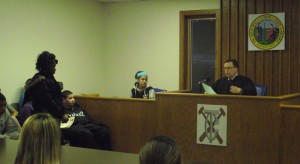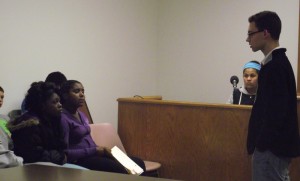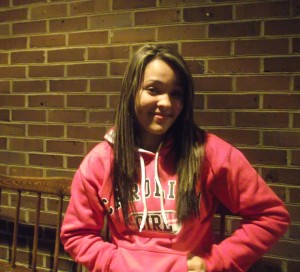04/23/2014



Law and Order in Robeson County’s Teen Court
A court run by teens helps keep their peers out of trouble in Robeson County.
By Hyun Namkoong
North Carolina is one of only two states in the country that try 16- and 17-year-olds as adults in its criminal justice system. This means that a lunchroom scuffle can leave an indelible mark on a high school kid’s record.
The North Carolina Academic Center for Excellence in Youth Violence Preventionwants to keep young people out of jail. It’s an organization that implements programs to address violence in Robeson County – one of the poorest counties in the state – through a collaboration that involves community, school and health organizations as well as the UNC School of Social Work and nearly $6.5 million from the Center for Disease Control and Prevention’s National Center for Injury Prevention and Control.

Judge J. Stanley Carmical speaks to juror Derrica Lorick, 14, while juror Danny Carver, 13, and clerk Hannah De La Cruz, 13, look on. Photo credit: Hyun Namkoong
NC-ACE uses its Teen Court to divert first-time nonviolent offenders from district and juvenile court.
“A kid who fights? Assault. That’s it. A criminal record for life,” said Jim Barbee, center coordinator, of what can happen when a young person enters the adult criminal-justice system.
Teen Court, he said, “is a great opportunity to give them a second chance.”
Positive peer-pressure in the courtroom
The small, crowded courtroom in the Robeson County Board of Elections building looks a lot like any courtroom you might see on TV, with the notable exception of the dozen teenagers who act as jury, defense attorney, prosecution and clerk.
A 15-year-old girl swears in the proceedings of the court and Judge Stanley Carmical allows the defense attorney and the prosecution to make opening remarks.
A jury of nine teenagers listens to the case of a teen who has been charged with disorderly conduct in his English class.
During questioning, the defendant admits that he causes disruptions, but only in English class because of the frustration he feels from lagging behind in reading.
Teen Court targets offenders aged 11 to 17 years old who have been charged with a nonviolent offense, such as simple possession of marijuana, disorderly conduct or underage consumption of alcohol.
The objective is to lower recidivism – the likelihood of reoffending criminal behavior that lands teens right back into trouble – through positive-action peer modeling. Offenders are paired with a peer who acts as their defense attorney during their trial. Research shows that during the turbulent years of adolescence, peers have the most influence on social behavior.
Following the closing remarks from the defense attorney and prosecution, Judge Carmical allows the jury to deliberate the details of the trial and decide on the sanctions for the defendant, which are akin to a sentence.
The members of the jury have all been in the shoes of the defendant. First-time offenders are all required to serve at least one session of jury duty as a part of their sanctions. Social-control theory suggests that teens respond better to sanctions from their peers rather than adults.
As facilitators for the jury deliberations, Alejandra Reyes and Colin Benton, students at UNC-Pembroke, follow the jury to a roundtable discussion.
“I see a lot of improvements,” Benton said of the teenagers who serve on the jury. “Biggest thing I like is, I get to see them grow as a person.”

Attorney advocate Samuel Deese, 18, speaks to jurors (l to r) Derrica Lorick,14, and Sandy Miller,13. Photo credit: Hyun Namkoong
Behind closed doors, the jurors discuss the frustrations of falling behind in class and problems with teachers. One juror thinks the defendant might have a self-esteem problem as a result of his difficulty with reading. Another teen talks about his own experience of acting out when he didn’t understand the class material.
Teen Court uses a restorative-justice model, which goes beyond punishment. It emphasizes offender accountability, restoring community trust in the offender and reparation.
After much deliberation, the jury members agree upon a sanction of 18 hours of community service and five sessions of duty on Teen Court. The defendant must also write a letter of apology to his classmates for disrupting the class. The jury also instructs the defendant to attend self-esteem, anger-management and good-decision seminars. It further recommends a parent-teacher conference and English tutoring for the defendant.
“We don’t try guilt or innocence. We focus on kids having accountability,” Barbee said.
Violence prevention is health related
At first glance, Teen Court doesn’t appear to be a health-related intervention. But Brad Bartholow, a research psychologist with the CDC, argues otherwise.
“The CDC considers violence a public-health issue,” he said. “Plenty of health departments don’t think that. They think about flu, immunizations.”
The CDC and other health organizations have started to more closely examine “social determinants” of health. These are the social, economic, environmental and political forces that shape and impact people’s health. Social determinants of health are commonly referred to when discussing health disparities between different populations.
Robeson County is one of the few rural counties in the nation that has a majority-minority population – that is, the total of the black, Latino and Lumbee Indian populations comprises a majority.
Nationwide, black communities are disproportionately affected by incarceration. Black adolescents represent more than half of the youth who are admitted to state prisons.
A study from Princeton University investigating the impact of a criminal record on job seekers found that it reduces the likelihood of getting an interview by 50 percent for white males. The findings paint an even more dire picture of black males with a criminal record: They’re significantly less likely than white males with a criminal record to secure stable employment after incarceration, rendering major economic and social ramifications for their communities.
“Health consequences from violence are a tremendous cost to society, financially,” Bartholow said.
Hope for a brighter future
The focus of social determinants on health also underscores the role that place and environment play in affecting health outcomes.
Gun violence, drug trafficking and high rates of crime are commonly associated with inner cities, which is why the rolling acres of farmland, the winding Lumber river and the swamps of Robeson County make it seem an unlikely place for the state’s highest homicide and juvenile-arrest rates.

Teen Court juror Cierra Dial, 17, says she learned to avoid trouble through participating in the Teen Court process. Photo credit: Hyun Namkoong
I-95 roars through the idyllic scenery of Robeson County; it’s approximately halfway between Miami and New York City. Eager to attract businesses to the area, local officials promote the county’s “Interstate logistics,” but illegitimate businesses, includingdrug trafficking by national and international cartels, have also capitalized on the county’s strategic location.
Throughout the years, there have been multiple drug busts, sting operations and even high-profile cases of corruption involving the sheriff’s department.
Robeson County offers few opportunities for its young people. The inescapable violence, poverty and crime have the potential to create a sense of fatalism for young people and the direction their lives can take.
But preliminary evaluation of the Teen Court program indicates that it’s successful in increasing optimism and hope for the futures of its teen participants.
Cierra Dial, a 17-year-old who was charged with larceny and now serves as a Teen Court jury member, said that she is looking to the future and would like to pursue a career in nursing or dental care.
“I’m not shoplifting again,” Dial said.
“I put effort in it and try my best,” she said.
No comments:
Post a Comment